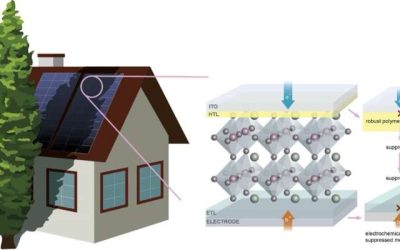Perovskites are materials with advantageous optoelectronic properties that could be used to develop more affordable photovoltaics (PVs). While in recent years engineers were able to significantly improve the power-conversion efficiencies of perovskite solar cells,...
Energy & Green Tech
One-step electrochemical regeneration of CO₂ from (bi)carbonates enhances carbon capture efficiency
While systems that can generate energy from renewable sources are becoming increasingly widespread, it might take a while before these systems fully replace solutions that rely on the burning of fossil fuels. In the meantime, researchers have been trying to develop...
Study disproves idea that weather-dependent renewable energy systems are more prone to blackouts
Wind turbines and photovoltaics (PVs) are becoming increasingly widespread worldwide, which could contribute to reducing air pollution caused by fossil fuel emissions. To produce energy, however, these renewable energy solutions rely on specific weather conditions...
Reliably estimating the capacity of household systems to store the excess electricity generated by photovoltaics
The use of photovoltaics (PVs) to generate household electricity is on the rise, as a growing number of individuals worldwide are now choosing to power their home using solar panels. To store the excess energy generated by solar panels on sunny days and re-use it at...
Study sheds light on the paths leading to the degradation of layered Li-rich oxide cathodes
In recent years, researchers have been trying to develop increasingly advanced battery technologies that can store more energy, recharge faster, discharge slower, and have longer lifespans. To achieve this, many have been experimenting with new cathode materials, as...
Dielectric protocol leads to high energy density in Li-metal pouch cells
The interface between electrodes and electrolytes largely contributes to the efficiency with which batteries convert energy. In recent years, many efforts aimed at developing better performing batteries have focused on tailoring the electrode/electrolyte interface to...
Asymmetric electrolyte design enables high-capacity anodes in lithium-ion batteries
Lithium-ion batteries (LiBs) have become the most widely used rechargeable batteries worldwide. Energy researchers and material scientists have been trying to identify alternative materials that could serve as LIB components, potentially leading to improvements in...
Catalyst design boosts performance of anion-exchange-membrane fuel cells
Fuel cells are energy-conversion solutions that generate electricity via electrochemical reactions without combustion, thus not contributing to the pollution of air on Earth. These cells could power various technologies, ranging from electric vehicles to portable...
Engineering approach can improve stability of perovskite solar cells under reverse bias conditions
Solar cells based on perovskites, a versatile class of materials with promising optoelectronic properties, are gradually making their way toward commercialization. While these solar cells can have notable advantages over existing solar cell designs, including higher...
Ultra-stable layered oxide cathodes could boost battery performance
Recent efforts aimed at developing more advanced battery technologies have in great part focused on designing novel cathode materials. This is because existing cathodes do not perform well at high voltages and can contribute to the rapid loss of battery capacity.










